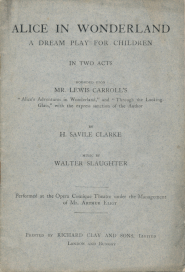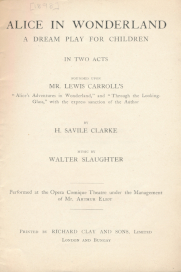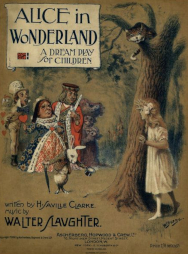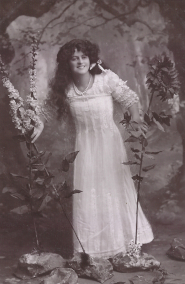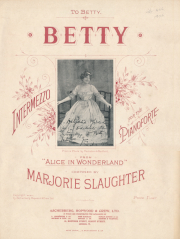Libretto: 1886 and 1888
1: 1886, First Version
This is the original version, performed when the show opened on 23 December 1886.
The cover is annotated above the title “First Edition, under revision”.
A digitised copy is available online from the Parrish Collection, Princeton University: Click Here
A second copy is available online from the Cotsen Children’s Library, Princeton University: Click Here
Note: the blank pages are not shown in this scan.
Page 31, Act II begins with the short Mirror Scene, removed in the Revised Versions. Click Here to see this page
Variant Covers:
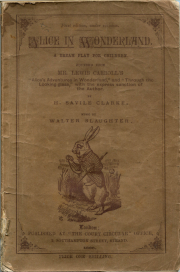
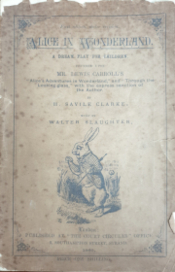
Left: First Edition, Under Revision
Front cover printed in dark brown ink
No advertisement on the back cover.
Image courtesy of Jon Lindseth
(Lindseth Collection now at Christ Church, Oxford)
Right: First Edition, Under Revision
Front cover printed in black ink
Advertisement for Chlorodyne on the back cover.
Image courtesy of Richards Collection
2: 1886, First Revised Version
This version lacks the cover annotation “First Edition, under revision”.
Copies are held in the British Library and in the Lindseth Collection at Christ Church, Oxford.
At the end of the text on page 54 is the print number 3-18-1-87, believed to indicate print run 3, made on 18 January 1887.
Major changes include the removal of the looking-glass scene at the beginning of Act 2 (First edition page 31, Revised editions page 29), adding more verses to ‘The Walrus and the Carpenter’ with the appearance of oyster ghosts who give them indigestion and dance a hornpipe (Revised editions pages 40-41), giving the White Knight more dialogue and a new song, ‘The Waits’ (Revised editions pages 49-51). Believed to have undergone minor amendments and been replaced very quickly by the Second Revised Version.
Page Images:
Pages 48-49: Click Here (Image courtesy of Jon Lindseth - Lindseth Collection now at Christ Church, Oxford)
Pages 50-51: Click Here (Image courtesy of Jon Lindseth - Lindseth Collection now at Christ Church, Oxford)
Page 54 (with print number): Click Here (Image courtesy of Jon Lindseth - Lindseth Collection now at Christ Church, Oxford)
Front Cover:
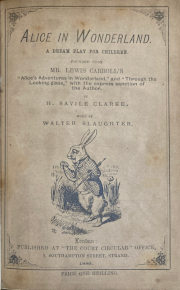
Image courtesy of Jon Lindseth (Lindseth Collection now at Christ Church, Oxford)
3: 1886, Second Revised Version
This is believed to be the version performed from late January 1887 at the Prince of Wales’s Theatre, London, through to the end of the provincial tour in August 1887.
A PDF file, scanned from a copy in the Richards Collection is available on this website: Click Here
This version retains the major changes made in the first revision, but differs in smaller details e.g. the scene between Alice and the White Knight (pages 49-51).
Known variant print numbers are 5-24-1-87, 6, 7, 8, 9, 10 and un-numbered.
Front Cover:
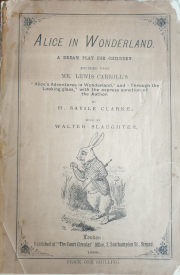
Image courtesy Richards Collection
Note that the 1886 reprinting of the fifth edition (79th to 83rd thousand) of Alice’s Adventures in Wonderland changed the verses of ‘‘Tis the voice of the Lobster’ to those of the stage version, as mentioned in the preface to A Bibliography of the Works of Charles Lutwidge Dodgson (Lewis Carroll) by Charlie Lovett (LCSNA, 2024).
Libretto: 1888
Henry Savile Clarke made further significant changes for the 1888 revival. The banqueting scene at the end of Act II saw the addition of more dialogue for the Red and White Queens with Alice, and a new song — the ‘Fish Riddle’, whilst the song ‘To the Looking-Glass World’ was replaced by the shorter ‘Sound the Festal Trumpets’ (pages 54-56).
A variant edition was printed for use as acting copies by performers etc. with identical text, but printed on larger, thicker paper, one side only and lacking a cover.
Note that all three editions of The Lewis Carroll Handbook, and the 1928 Parrish Collection Catalogue, all refer to versions dated 1889. However, at least one of these references is a typographical error relating to the 1898 Opera Comique production; there is no 1889 printing of the libretto at Princeton University (where the Parrish Collection now resides) and no copies have been identified elsewhere.
A digitised version of the 1888 libretto is available online from the Parrish Collection, Princeton University: Click Here
Covers:
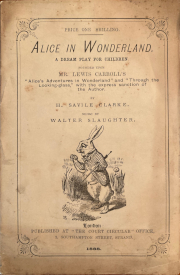

Left: Front Cover
Right: Back cover with advertisement for Ridge’s food, parodying ‘You are old, Father William’.
Images courtesy of a private collection
Known Extant Copies:
For a preliminary census of copies of the 1886 and 1888 editions, click here
Further information on the revisions:
‘Savile Clarke’s Alice in Wonderland – A Dream Play, or the Case of the Crucial Comma.’
By Selwyn H. Goodacre and Jeffrey Stern
In: JabberwockyIssue 65 (Vol. 15, Nos. 1 & 2), Winter/Spring 1986, pages 7-13.
Alice on Stage
By Charles C. Lovett
Meckler, 1990.
‘A note on Savile Clarke’s Alice in Wonderland: A Dream Play for Children, including a newly identified third edition‘
By Jon Lindseth
In The Carrollian, Issue 22, Autumn 2008, pages 25-30.
‘Through the Looking-Glass, and what Henry Savile Clarke did there.’
By Catherine Richards and Clare Imholtz
Chapter 31 in Through the Looking-Glass. A Companion
Peter Lang, Oxford, 2024.
These pieces all make specific reference to the revisions made to the play. For a more detailed bibliography visit the Introduction page.
